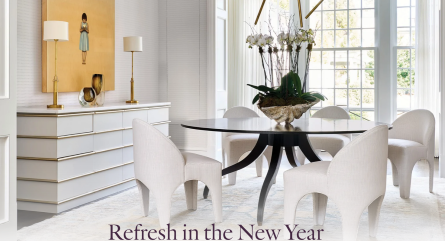HANOI, Vietnam — We at Home News Now have spilled a lot of digital ink chronicling the growth of the Vietnamese furniture manufacturing sector, and deservedly so, given the U.S. market’s dependence on Vietnam. But, this supply chain focus has perhaps overshadowed the growing retail scene here.
Sadly for the Vietnamese furniture industry, the boomlet in new stores is dominated by foreign concerns. Increased domestic demand for furniture could be providing much-needed relief for those factories here that have seen precipitous drops in orders. Home News Now reported on this post-pandemic correction in global supply chains back in June.
According to a report in the Vietnamese newspaper The Star, among the most recent arrivals to the furniture retail party are stores specializing in European styling, in particular Danish styling.
Danish furniture companies have seemingly always exercised more influence and enjoyed greater prominence than their relative industry’s size would otherwise suggest. When the Danes enter a market, they soon end up leading that market in styling, innovation and presentation, as well as in meaningfully working in their manufacturing practices for a more sustainable Earth.
BoConcept and JYSK are among the more prominent Danish retail chains with footholds in Vietnam.
A 45-year-old company with more than 3,300 stores in 48 countries around the world, JYSK is, improbably, still family owned. Not surprisingly, nearly 1,000 of its stores are in Denmark, but missing from that list of 48? The United States. At least for now.
JYSK just opened a store in the Indochina Plaza Hanoi Residences complex in central Hanoi, giving the Aarhus, Denmark-based company a dozen stores in the country. JYSK has been trading in Vietnam since 2015.

The new store covers furniture, bedding, lighting and outdoor to total 1,000 SKUs on display.
Hanoi is in the north, near the border with China. Anchoring south Vietnam is Ho Chi Minh City, where BoConcept has three locations. BoConcept’s U.S. presence spans the coast’s 16 store locations, part of a 300-store network globally in 65 countries.
Other retailers with growing presences here, most of them emphasizing European styling, include AConcept, MOHO, Nha Xinh, Chilai, Premium Furniture, Sonder Living, Index Living Mall and Come Home.
Thai-Vietnamese trade
That last mention, Come Home, is a new division and brand for Thailand’s Central Retail, a launch that marks the conglomerate’s first foray into home furnishings. The Bangkok-based company is a major player in food, fashion and cosmetics, but now is adding home furnishings and décor to its portfolio, and it is using the Vietnamese market in which to do it.
Thailand is Vietnam’s largest trading partner in ASEAN and Vietnam is Thailand’s fifth-largest trading partner worldwide, so it shouldn’t surprise that of Central Retail’s $1 billion committed to growing its businesses, a large chunk of that is earmarked for Vietnam, according to The Star.

“We have meticulously prepared for this launch over a span of two years, aiming to spearhead Vietnam’s interior decor market,” a spokesperson from Central Retail told Vietnamese news source Tuoi Tre. The representative identified living room furniture, bedroom furniture and decorative items as the categories with the most potential to generate sales.
Olivier Langlet, CEO of Central Retail Vietnam, described Ho Chi Minh City as “the economic locomotive of the country.”
Research conducted by Central Retail predicts Vietnam’s retail furniture sector will reach $1.4 billion by 2024, research that has this sector growing at a rate of about 10% for each of the next five years. These predictions are shared by Mordor Intelligence, which projects Vietnam’s retail furniture sector reaching $1.82 billion by 2028.
These estimates are probably a bit optimistic, as Central Retail’s recent share prices on the Thai stock exchange reflect, but with the launch of Come Home, the parent company is in it for the long haul. Come Home’s first store location went into the SC VivoCity Shopping Centre in Ho Chi Minh City.

While Vietnamese-produced furniture can be found in stores all over the United States and Europe, it is woefully under-represented at home.
The export focus is “a missed opportunity” for domestic producers, said Phung Hoa Cuong, CEO of Hanoi retailer Furniland, speaking to Tuoi Tre. “Considering [Vietnam’s] status as the second-largest wood furniture exporter in Asia, making these globally recognized products available domestically would quickly garner significant market share.”
Regional economic outlook
Vietnam’s importance to the U.S. economy was underlined in July when U.S. Treasury Secretary Janet Yellen paid a visit. And while the Vietnamese economy appears robust, there are reasons to be concerned. FitchSolutions’ BMI recently lowered its growth forecast for Vietnam to 5% from 5.8%, largely because of reduced global demand for Vietnamese-made goods. Year-over-year GDP growth in the second quarter sputtered at 4.1%, according to BMI.
Of course, Vietnam’s economic fortunes are intertwined with those of China. If China’s post-pandemic economic recovery resumes, the consequent boost for Vietnam would limit the broader economic slowdown and bolster the currency here. But that resilience will have to prove nothing less than stunning in 2023’s last four months to offset an imploding real estate sector, and annual growth that so far this year is running at less than half of what China is accustomed to enjoying, 3% as compared to the more pre-pandemic normal of about 8%.
Economists are watching to see whether China’s economic tremors presage a collapse, an unlikely scenario but one that could drag down a global economy already showing signs of stress. And, as a recent New York Times article pointed out, Americans are partly to blame.
“This year, with home offices and patios stuffed full of furniture and electronics,” the Times article described, “Americans are spending their money on cruises and Taylor Swift tickets instead.”
Stuffed? Hmm . . . maybe.
Saddled also with a relatively weak currency, China is not surprisingly seeking relief by encouraging exports — going on offense instead of playing defense. This brings us back to Vietnam, because to the extent U.S. demand for Chinese furniture increases, that demand will displace need for Vietnamese-made goods. With one caveat: Chinese manufacturers will continue to dodge U.S. tariffs on furniture by relying on production in Vietnam and, as we’ve also carefully chronicled, Mexico, as well.
Next stop: Sydney, Australia
Let’s head about 4,200 miles due south of Ho Chi Minh City to check in on the retail scene in Sydney, where RH has a big new store on tap.
Carrying a projected price tag of about $91 million ($140 million Australian), the new RH luxury gallery set for Sydney’s upscale Double Bay area will stretch up five levels and sport a rooftop restaurant, according to a report in the Sydney Morning Herald.
This puts the store (and the RH Interior Design Studio it will contain) right in the heart of the Pallas Group real estate empire. Pallas owns Fortis, which is headquartered in Double Bay.
According to the newspaper, RH will occupy a footprint of more than 36,000 square feet on a site purchased by Fortis for approximately $32 million ($49 million Australian). The store is expected to open in late 2025, joining five other Fortis-developed commercial buildings.
Fortis reported a $8.3 million pre-tax profit for fiscal 2022 on revenues of $42.1 million, according to The Australian newspaper.
While we are on the topic of RH, as promised during its last shareholders meeting in February, the company published its first Interiors Source Book since 2020, a mammoth tome clocking in at 604 pages.
Accessible online, the source book ripples with approximately 100 exclusive collections in what RH is calling the largest fully integrated luxury home furnishings assortment in the world. These collections represent the work of an impressive list of designers from all over the world. For example, Italy-based Francesco Crivellari has three upholstery collections in the book, Bella, Dillon and Durham.

The cover features the Byron collection in European white oak designed by Sydney-based Harrison and Nicholas Condos. Byron, which will also be available in black oak, is expected in September. Also shown is a Jakob lounge chair, one of several expected in mid-October. News of the dazzling new digs in Sydney and the big new source book coincided with good vibes for RH on Wall Street. The company has been outperforming the broader market, and last month investment firm FMR snapped up 265,000 shares in RH to give it a 12.2% stake in the company.





